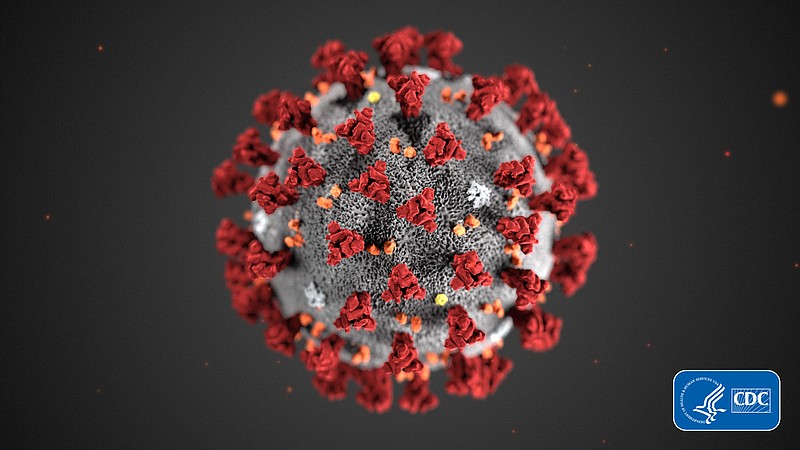As a service to our readers, The Sentinel-Record publishes updates released by the city of Hot Springs and the state of Arkansas.
The following stats were posted Tuesday on the Arkansas Department of Health's website:
• 267,522 cumulative confirmed cases, up 111 from Monday.
• 113.71 rolling seven-day average of new confirmed cases, up 8.71 from Monday.
• 3,071,169 PCR test reports, up 1,938 from Monday.
• 8.7% cumulative PCR infection rate, no change from Monday.
• 75,204 cumulative probable cases, up 120 from Monday.
• 14.4% cumulative antigen infection rate, no change from Monday.
• 335,156 recoveries of confirmed and probable cases, up 166 from Monday.
• 1,656 active confirmed and probable cases, up 62 from Monday.
• 2,651,460 vaccine doses received, no change from Monday.
• 2,019,977 doses given, up 6,133 from Monday.
• 204 hospitalizations, up 29 from Monday.
• 37 cases on a ventilator, up four from Monday.
• 87 ICU admissions, up seven from Monday.
• 4,644 confirmed deaths, up two from Monday.
• 1,208 probable deaths, up one from Monday.
• 2,092 nursing home deaths, no change from Monday.
• 8,697 cumulative confirmed cases, up one from Monday.
• 3.86 rolling seven-day average of new confirmed cases, up 0.15 from Monday.
• 118,763 PCR and antigen test reports, up 53 from Monday.
• 90,611 private lab reports, up 52 from Monday.
• 28,152 public lab reports, up one from Monday.
• 8.5% cumulative PCR infection rate, no change from Monday.
• 31 active confirmed cases in Garland County, down five from Monday.
• 8,452 recoveries of confirmed cases in Garland County, up six from Monday.
• 1,667 cumulative probable cases in Garland County, up three from Monday.
• 16 active probable cases in Garland County, up one from Monday.
• 214 confirmed deaths, no change from Monday.
• 49 probable deaths, no change from Monday.
The net increase of 29 COVID-19 patients in hospitals reported Tuesday was the largest single-day increase since Jan. 11, the day hospitalizations peaked at 1,371.
The 204 hospitalizations reported Tuesday were the highest single-day count of the spring, surpassing the 203 reported May 20 and 27. Hospitalizations in the 25-48 age group rose 64% from March 21 to May 21, according to information Gov. Asa Hutchinson presented Tuesday at his weekly press briefing.
"That's the gap in our vaccinations," he said. "The older are getting vaccinations. We have to get that younger group, the working person, vaccinated."
Hospitalizations in the 24 and younger group were flat from March to May, but Dr. Jose Romero, the state's secretary of health, said adolescents age 12 to 15 have had extended hospital stays. The Morbidity and Mortality Weekly Report the Centers for Disease Control and Prevention released last week assessed 204 adolescent hospitalizations. About one-third required admission to intensive care units and 5% required mechanical ventilation.
"Infection by COVID in this age group is not benign," Romero said. "The disease is significant, and it can result in long-term stays in intensive care. We know the vaccine is safe and effective in this age group, and that we can prevent this type of serious illness."
Following CDC guidance, the governor announced Tuesday that fully vaccinated students aged 12 to 18 will not have to quarantine after exposure to a COVID-19 case. They can continue attending school and participating in extracurricular activities. Fully vaccinated teachers and college students will also not have to quarantine, Hutchinson said.
"What this means for the students is it will minimize education loss," he said. "They will be able to stay in the classroom. They won't have to quarantine. They'll be able to continue their education, even if they've been exposed to someone with COVID-19
"Secondly, it will minimize disruption to the workforce. We've all seen stories about parents having to go out of the workforce for 10 to 14 days because their child is home because they've been quarantined."
Romero said 10% of the state's 12- to 18-year-olds have been vaccinated.
"We've begun immunizing this age group, but we need to use these summer months to move forward with vaccination," he said. "It will impact on their sports during the summer. This will keep the teams together and allow them to practice together."
